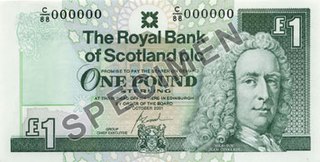
The Bank of England is the central bank of the United Kingdom and the model on which most modern central banks have been based. Established in 1694 to act as the English Government's banker and debt manager, and still one of the bankers for the Government of the United Kingdom, it is the world's eighth-oldest bank.

A banknote—also called a bill, paper money, or simply a note—is a type of negotiable promissory note, made by a bank or other licensed authority, payable to the bearer on demand. Banknotes were originally issued by commercial banks, which were legally required to redeem the notes for legal tender when presented to the chief cashier of the originating bank. These commercial banknotes only traded at face value in the market served by the issuing bank. Commercial banknotes have primarily been replaced by national banknotes issued by central banks or monetary authorities.

The pound sterling is the official currency of the United Kingdom, Jersey, Guernsey, the Isle of Man, British Antarctic Territory, South Georgia and the South Sandwich Islands, and Tristan da Cunha.

The Bank of Scotland plc is a commercial and clearing bank based in Edinburgh, Scotland, and is part of the Lloyds Banking Group. The bank was established by the Parliament of Scotland in 1695 to develop Scotland's trade with other countries, and aimed to create a stable banking system in the Kingdom of Scotland.
Banknotes have been issued for use specifically in Northern Ireland since 1929, and are denominated in pounds sterling. They are legal currencies, but technically not legal tender anywhere. This is not uncommon as most bank notes are not recognised as tender. However, the banknotes are still widely accepted as currency by larger merchants and institutions elsewhere in the United Kingdom. Issuing banks have been granted legal rights to issue currency, and back the notes with deposits at the Bank of England.

The Bank Charter Act 1844, sometimes referred to as the Peel Banking Act of 1844, was an Act of the Parliament of the United Kingdom, passed under the government of Robert Peel, which restricted the powers of British banks and gave exclusive note-issuing powers to the central Bank of England. It is one of the Bank of England Acts 1694 to 1892.
Backhouse's Bank of Darlington was founded in 1774 by James Backhouse (1720-1798), a wealthy Quaker flax dresser and linen manufacturer, and his sons Jonathan (1747-1826) and James (1757-1804).
Banking in the United Kingdom can be considered to have started in the Kingdom of England in the 17th century. The first activity in what later came to be known as banking was by goldsmiths who, after the dissolution of English monasteries by Henry VIII, began to accumulate significant stocks of gold.

The Bank of England, which is now the central bank of the United Kingdom, British Crown Dependencies and British Overseas Territories, has issued banknotes since 1694. In 1921 the Bank of England gained a legal monopoly on the issue of banknotes in England and Wales, a process that started with the Bank Charter Act of 1844 when the ability of other banks to issue notes was restricted.

The Bank of England Act 1716 was an Act of the Parliament of Great Britain. It was one of the Bank of England Acts 1694 to 1892.

The Bank of England Act 1709 was an Act of the Parliament of Great Britain. It was one of the Bank of England Acts 1694 to 1892.

The Banking Act 2009 is an act of the Parliament of the United Kingdom that entered into force in part on the 21 February 2009 in order, amongst other things, to replace the Banking Act 2008. The Act makes provision for the nationalisation of banks, amends the law on bank insolvency and administration, and makes provision about the Financial Services Compensation Scheme. It also makes provision about the regulation of inter-bank payment schemes, amends the law on the issue of banknotes by Scottish and Northern Irish banks, and makes other miscellaneous amendments to the law on banking.

The Short Titles Act 1896 is an Act of the Parliament of the United Kingdom. It replaces the Short Titles Act 1892.

The Bank of England Act 1694, sometimes referred to as the Tonnage Act 1694, is an Act of the Parliament of England. It is one of the Bank of England Acts 1694 to 1892.

The Bank of England Act 1696 was an Act of the Parliament of England. It was one of the Bank of England Acts 1694 to 1892.
Bank Notes Act is a stock short title used in the United Kingdom for legislation relating to bank notes.

The Royal Bank of Scotland £1 note is a sterling banknote. The current cotton note, first issued in 1987, bears an image of Lord Ilay, one of the founders of the bank, on the obverse, and a vignette of Edinburgh Castle on the reverse.

The Bank Notes (Scotland) Act 1765 was an Act of the Parliament of Great Britain that introduced restrictions on the use of banknotes by the Scottish banks. The act was from the Fourth Session of the Twelfth Parliament of Great Britain at Westminster; beginning May 19, 1761 and lasting until January 10, 1765.

The Craven Bank was a financial institution founded in 1791 in Settle, North Yorkshire to provide banking services in the area. Incorporated as the Craven Bank Ltd - a joint stock company - in 1880, the bank amalgamated with the Bank of Liverpool in 1906.












